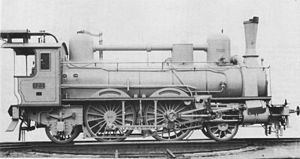StEG II 65-122
| StEG I / StEG 23.01–26 / MÁV Ig 601–632 / kkStB 5 / BBÖ 5 / MÁV 223 / GySEV Ig 201–206 | |
|---|---|
|
StEG 122 later MÁV Ig 632, MÁV 223,032
|
|
| Numbering: | StEG II 65–122 MÁV Ig 601–632 MÁV 223.001–032 StEG 23.01–26 kkStB 5.01–26 BBÖ 5.01–26 (with gaps) GySEV 201–206 |
| Number: | StEG: 58 MÁV: 32 (from StEG) kkStB: 26 (from StEG) BBÖ: 24 (from kkStB) GySEV: 6 (from BBÖ) |
| Manufacturer: | StEG , Hanomag |
| Year of construction (s): | 1882-1885, 1889, 1891 |
| Retirement: | BBÖ: until 1928 GySEV: until 1957 |
| Type : | 1B1 n2 |
| Gauge : | 1435 mm ( standard gauge ) |
| Length: | 9,226 mm |
| Height: | 4,320 mm |
| Fixed wheelbase: | 2,100 mm |
| Total wheelbase: | 5,700 mm |
| Wheelbase with tender: | 11,841 mm |
| Empty mass: | 42.8 t |
| Service mass: | 47.8 t |
| Friction mass: | 26.5 t |
| Top speed: | 80 km / h |
| Driving wheel diameter: | 1,820 mm |
| Impeller diameter front: | 1,120 mm |
| Rear wheel diameter: | 1,120 mm |
| Number of cylinders: | 2 |
| Cylinder diameter: | 430 mm |
| Piston stroke: | 650 mm |
| Boiler overpressure: | 9 atm |
| Number of heating pipes: | 163 |
| Grate area: | 2.31 m² |
| Radiant heating surface: | 10.36 m² |
| Tubular heating surface: | 133.14 m² |
| Tender: | 7 .01-26 |
The steam locomotives StEG II 65-122 formed an express train - series of locomotives with a tender of the Austro-Hungarian State Railroad Company (StEG), a private Austrian-Hungarian railway .
history
Since the StEG was founded with French capital, there was some influence from France on its locomotives. This also applies to the locomotives of this series, which were similar to the machines built by Camille Polonceau for the Paris-Orléans railway .
The StEG had 58 of these class I locomotives built. The StEG locomotive factory built 44 of them with the track numbers 65–74 (1882) and 89–122 (1883–1885, 1889 and 1891) as Type 77 and 14 with the numbers 75–88 Hanomag (1883). The 1B1 design has the advantage that a larger boiler can be accommodated than with a 2'B design. However, since only wedge surfaces were available as a reset device for the running axles, this was at the expense of the driving properties.
The machines in this series were stationed in Vienna East and Wessely .
After the separation of the StEG into the Austrian and the Hungarian part, 26 pieces remained in the Austrian part (StEG series 23.01–26 ), the rest of the MÁV initially formed Ig 601–632, from 1911 series 223 . After the nationalization of the StEG in 1909, the 26 Austrian locomotives came to the kk Austrian State Railways (kkStB) as class 5 and subsequently, except for the 5.17 and 5.15, which were retired in 1917 and 1918, to the BBÖ , 3 each in 1923 and 1924 sold to GySEV (201–206) and the other machines were removed from their inventory by 1928.
Of the MÁV machines, 14 came to Yugoslavia and one to Romania.
literature
- Locomotive types of the kk landesbef. Machine factory in Vienna of the priv. Austro-Hungarian State Railway Company . M. Engel & Sohn, kk Hof-Buchdruckerei und Hof-Lithographie, Vienna 1888.
- Karl Gölsdorf: Locomotive construction in old Austria 1837–1918 . Slezak publishing house, Vienna 1978, ISBN 3-900134-40-5 .
- Helmut Griebl, Josef Otto Slezak, Hans Sternhart: BBÖ Lokomotiv-Chronik 1923–1938 . Slezak publishing house, Vienna 1985, ISBN 3-85416-026-7 .
- Bernhard Schmeiser: Haswell, StEG and Mödling locomotives 1840–1929 (reprint) . Slezak publishing house, Vienna 1992, ISBN 3-85416-159-X .
- Heribert Schröpfer: Locomotives for Austrian railways - steam locomotives BBÖ and ÖBB . alba, Düsseldorf 1989, ISBN 3-87094-110-3 .
- Johann Stockklausner: Steam company in old Austria . Slezak Verlag, Vienna 1979, ISBN 3-900134-41-3 .
- Johann Blieberger, Josef Pospichal: Encyclopedia of the kkStB traction vehicles, volume 1. The rows 1 to 228 . bahnmedien.at, 2008, ISBN 978-3-9502648-0-7 .
